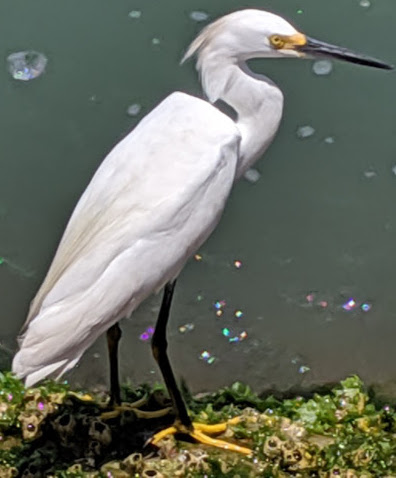by M. Kathy Raines
Snowy Egret – Elegant, Innovative Feeder

The snowy egret slipped its yolk-yellow feet, toes first, into waters of the saltmarsh and strode across, stealthy and alert, ready to strike.
Its feet, the proverbial “golden slippers” on which the bird “dances”, instantly identify this graceful, resourceful feeder in our marshes, mudflats and resacas, distinguishing it from the taller great egret, whose legs are black. Snowy egrets often snatch small prey from the rocks on our jetties, but I haven’t seen any there for months; nearby marshes must be offering superior dining.
These long-necked, dark-legged, yellow-footed shorebirds thrive here year-round. During breeding season, the egret’s bright yellow lores—featherless areas between the eyes and bills—redden, and long plumes on its head, neck and back blossom into lacy, upward curves, attire befitting a bride. But rare beauty, for birds living near humans, can prove troublesome. The painted bunting’s striking colors and the northern mockingbird’s beautiful melodies once popularized them as caged pets. The snowy egret’s stunning feathers, especially when in breeding splendor, led to their near demise in Texas when collectors sold them for ladies’ hats.

The snowy egret (Egretta thula) is one of 72 species, including egrets and bitterns, in the heron family or Ardeidae, whose members stalk, ambush and thrust at prey with knifelike bills. Also, herons’ vertebrae let them propel, then snap back, their sinuous necks.
Known for its flexible hunting techniques and broad diet, the snowy egret eats fish and invertebrates, including snails, crabs and insects. Both an ambush and active hunter, it may stand in water, awaiting prey that happens by, sometimes stirring or raking small creatures with one or both feet. The egret dabbles its bill tip in the water, attracting fish by mimicking the turmoil of a struggling insect. It runs in the shallows, with partially raised wings, its feet drawing out prey. It hovers, dropping upon quarry or flies head-down, catching fish discarded by shrimpers. It follows cattle, catching flushed insects. Masses of shorebirds feed together, and, since they all trigger prey, snowy egrets flourish in their company.
Egrets overcome refraction—light reflected from a fish that bends at the water’s surface, creating the illusion that it is elsewhere—impressively for a creature unschooled in mathematics. In laboratories, researchers have observed egrets aiming their bills at perfect angles to correct for refraction, almost never missing their targets. In the wild, of course, with preferred angles blocked, egrets position their bills as best they can.
A snowy egret raises and lowers its long, gauzy breeding feathers during courtship. The male finds a nesting site, then makes elaborate displays—sky-pointing, pumping his head up and down or flying high, then tumbling down or even leapfrogging over a mate. Alongside other shorebirds, the couple weaves together twigs, sticks and grass to create a shallow platform nest, often lined with Spanish moss, in trees, marsh vegetation or occasionally, the ground.

Downy chicks hatch in about 22 days. Parents tend to them closely, regurgitating food onto the nest floor for hatchlings. Older chicks grasp a parent’s bill—the connected bills resembling pairs of scissors—urging them to regurgitate into their mouths.
Chicks hatch at different times, and the last may starve or be bullied from its nest, perhaps into the jaws of an alligator. In the Florida Everglades and elsewhere, snowy egrets tend to build nests above alligator-rich waters, presumably for the protection these bodyguards offer them from raccoons, bobcats and other nest predators. Egrets strike a bargain: better to lose one chick to a gator than all to a raccoon.
Snowy egrets and other Texas shorebirds often “nest on isolated natural or dredge spoil islands in the Laguna Madre and other bays,” according to Justin LeClaire, Avian Conservation Biologist at the Coastal Bend Bays & Estuaries Program. Not only do these islands isolate them from people who “have overtaken much of the mainland habitats,” he said, but also provide “relief from most ground predators that can wreak havoc on a waterbird colony.” Raccoons and bobcats climb up to nests, and “roaming coyotes can pick off stragglers on the ground or in low shrubs,” he said.
Concerning these island rookeries, local Texas Master Naturalist Marilyn Lorenz said that “there are so many birds in such a small area that they all take defense of the nests and nestlings very seriously” and that a “predator is met with a veritable hurricane of angry birds of all the species present.”

Before passage of the Migratory Bird Treaty Act of 1918, snowy egret populations were decimated, but they are now flourishing, with ranges expanding northwards. Still, they warrant observation and care.
For Worlds Shorebirds Day, Saturday, September 9, Justin LeClaire is offering a presentation entitled “Shorebird Research and Conservation Along the Texas Coast” at 1:30 at South Padre Island Birding, Nature Center & Alligator Sanctuary. Those wishing to take a 9:00 a.m. tour and assist with counting shorebirds must make a reservation using this website: https://www.spibirding.com/programs-events.

